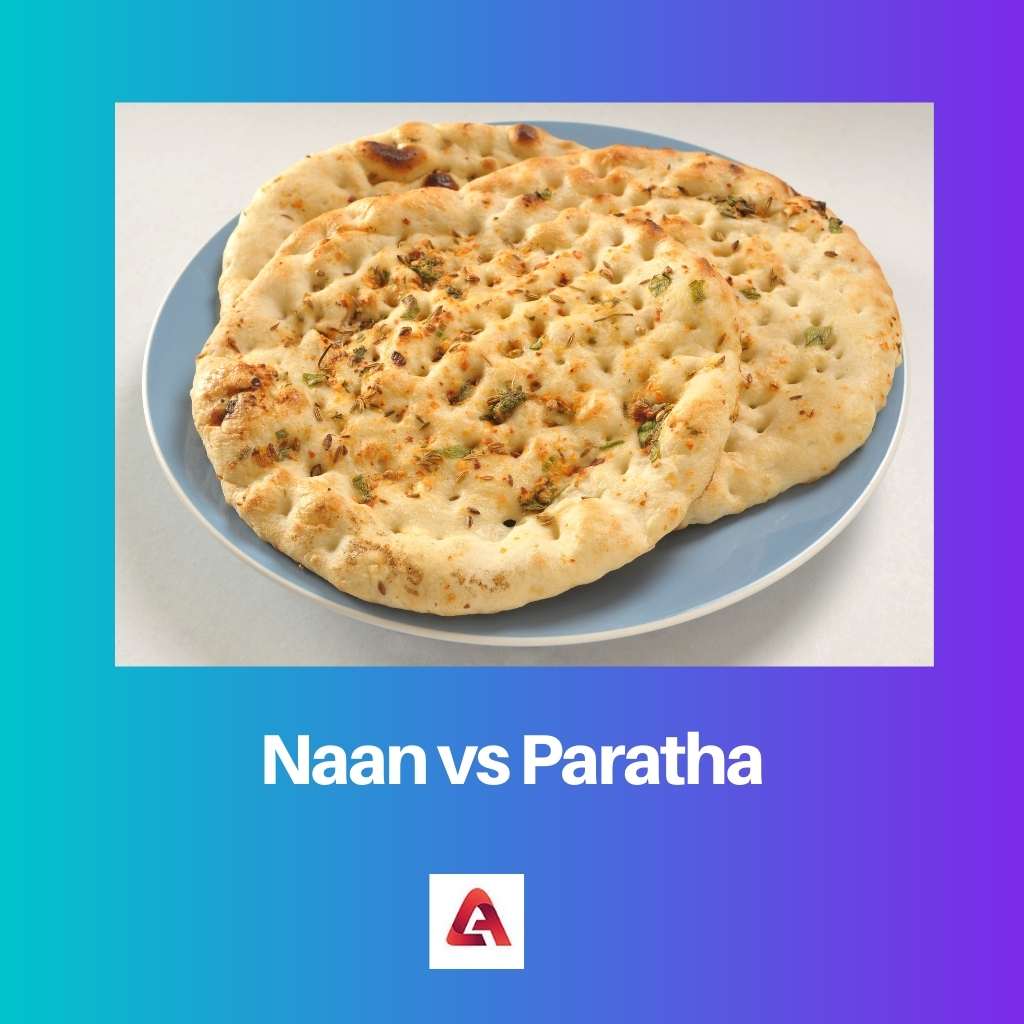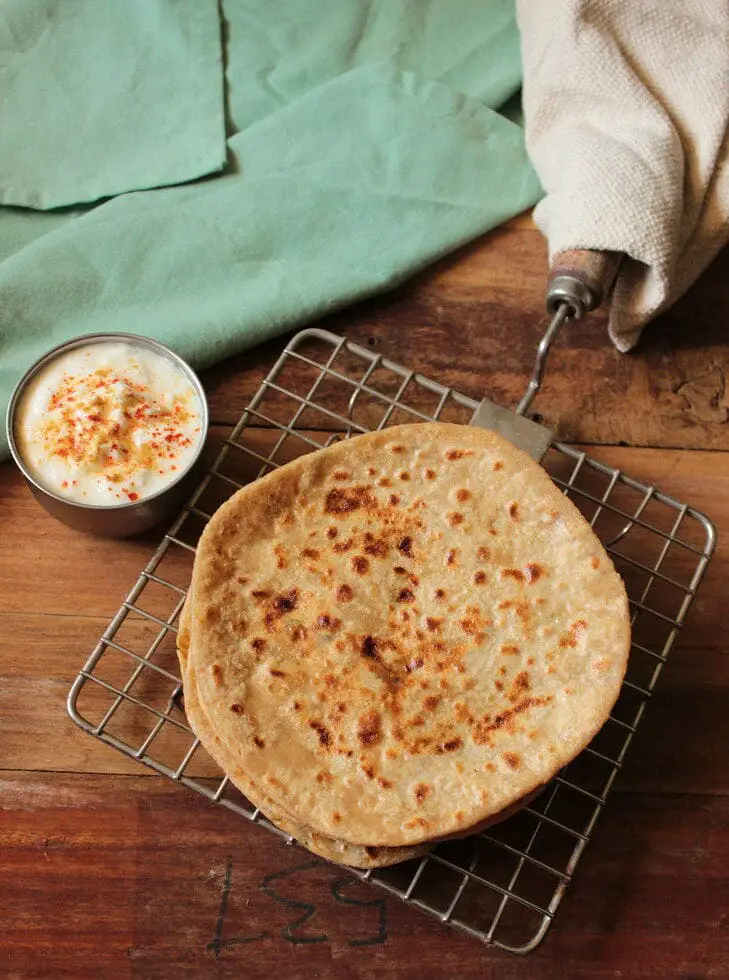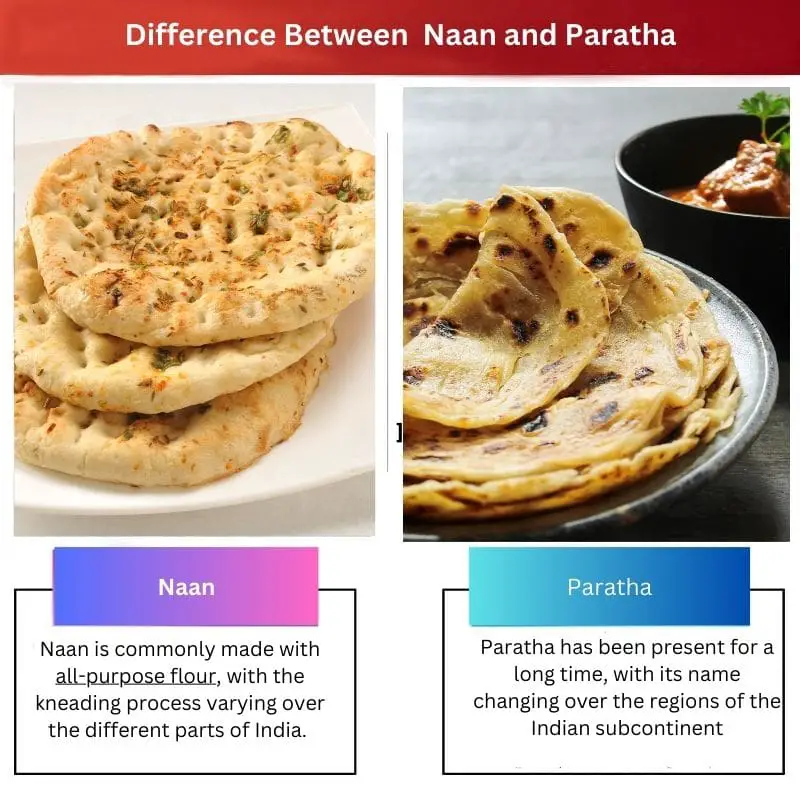Naan and paratha are Indian flatbreads that have gained popularity overseas and are loved by all. They have a unique and authentic taste that is a result of simple spices and Indian masala.
Now that their fame has spread all over the world, the dough mix can change according to the chefs.
Key Takeaways
- Naan is a leavened bread made with yeast, while paratha is an unleavened flatbread.
- Parathas contain layers of dough and can be stuffed with various fillings, while naan has a softer, fluffier texture.
- Naan is traditionally cooked in a tandoor oven, while paratha is prepared on a griddle or tawa.
Naan vs Paratha
The difference between naan and paratha is that naan is prepared in such a way that it remains a bit thick and has volume whereas paratha tends to be quite flaky and soft and depending on the chef, they can also make it a bit crunchy with the addition of certain unsaturated fats. Both are seen as carbohydrate-filled meals, eaten with a complimentary side dish.

Naan is commonly made with all-purpose flour, with the kneading process varying over the different parts of India. The kneading decides the volume and thickness of the naan. The more the chef kneads, the thicker the naan might be. The importance of the naan is decided by the method of cooking and placing the naan in an oven.
Paratha has been present for a long time, with its name changing over the regions of the Indian subcontinent. The most distinguishing factor of the parathas is that it is eaten in a flaky manner.
The layered bread needs to break off easily and have a slightly crunchy texture while at the same time being soft.
Comparison Table
| Parameters of Comparison | Naan | Paratha |
|---|---|---|
| Presence of Layers | No | Yes |
| Time Needed to Prepare | Comparatively less | More time is needed to form all the layers |
| Thickness and Volume Needed | Yes | No |
| Flaky and Soft | No | Yes |
| Cooking Oil Used While Cooking | Not always | Yes |
What is Naan?
Naan is an Indian flatbread that is prepared using white flour. Even though it is called bread, there is no addition of yeast to raise the bread, and therefore, it is called flatbread.
In other words, it is also called Indian bread instead of flatbread or naan. It has existed since ancient times in India and was consumed by people of all economic statuses.
Naan gained momentum in most menus during the times of the Mughal rulers.
But the chefs who prepared the food for them were reluctant to present the Royal Family with plain naan and then began the era of flavoured naans.
The old naan was then infused with Indian spices and flavours enhancing the taste with each bite. After the dough is prepared with salt or other seasoning, people tend to add potatoes, raisins, and nuts.
This dough is then kneaded for a long time in a specific manner to bring about a thick naan. After kneading, the dough is left to sit for some time, maybe even hours.
The more it sits, the better, as the higher the naan might rise. Then, small balls are made out of the dough,, which is rolled out or even shaped by the hand softly into a circle.
A circle is the most preferred shape of naan. But that doesn’t mean it is the only shape. For beginners, attaining a circular naan would be hard.
Once the naan is rolled out, it is put into an oven that, in the olden days, was made of stone. But now, people tend to cook it in Tawas or cast iron pans.
The most common time to eat naan is during breakfast. It is eaten with a wide variety of sauces or meat dishes.
Since yeast isn’t preferred to be added to naan, the rising agent is baking powder. Other than this, yoghurt is also used as a raising agent.
Naan tends to have higher fat content, so people on a diet should eat less of it unless their body metabolism is delicious.

What is Paratha?
Paratha is another kind of flatbread that originated in the Indian subcontinent and was prepared without adding yeast.
The flour used for paratha is whole wheat flour; therefore, the flatbread might look brown after it is cooked. But flour usage is totally on the cook, and they can use regular white all-purpose flour too.
Paratha comes from two words, “par” and “atta”, which mean layered and wheat flour, respectively. It originated in the northern parts of India and from a few regions that are now included in Pakistan.
Parathas are filled with vegetables cooked in an Indian masala and then stir-fried to create a blend of spices unique to each region.
Vegetables are not the only thing that is used to fill inside a paratha, but meat varieties such as chicken and mutton are also used.
All the stuffing variations depend on the chef’s creativity and sense of taste. The dough is prepared after adding warm water into the flour, and the seasoning is added.
At times, to increase the quality of the paratha, ghee or cooking oil is added to the dough and therefore highlights the textural quality of the paratha.
After this, the dough is left to sit and set in correctly so that the rolling becomes easier. There are a series of layering procedures that helps in attaining the flaky texture of paratha.
It is made to be a semi-thick rolled-out flatbread which is then kept in a regular Tawa to be cooked. While cooking, fresh ghee is added wh,ich contributes to the smell of the freshly cooked paratha.
It is, at times, eaten plain without any curries or other condiments. It could be rolled up into cylinders, drizzled with sugary syrup, and then eaten with tea or Indian chai.
The shape is commonly circular, but depending on the chef’s creativity, they can roll it out in any form they want.

Main Differences Between Naan and Paratha
- Naan is commonly prepared with white flour, which adds its volume and slightly rubbery texture. In contrast, parathas are commonly prepared with wheat flour, which helps gain a proper crunchy and flaky texture.
- While cooking, oil or butter is added to parathas to maintain flakiness, whereas, in the case of naan, no additional unsaturated fats are added at the time of cooking.
- Naan is a single-layer flour bread, whereas parathas are multi-layered, making them slightly flaky.
- The fatty content in paratha is high when compared to naan due to all the oil added in during kneading as well as during cooking.
- It is not common for naan to be consumed sweetly, but parathas are eaten sweetly.





